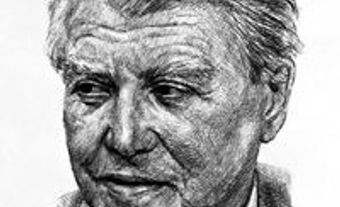Guglielmo Giovanni Maria Marconi, electrical engineer, inventor and businessman (born 25 April 1874 in Bologna, Italy; died 20 July 1937 in Rome, Italy). Marconi’s early experiments in wireless telegraphy demonstrated the potential of long-range radio communication. He is generally considered the inventor of the radio. Marconi’s first reputed reception of a transatlantic radio signal occurred at Signal Hill in St. John’s, Newfoundland, in 1901. The following year, he built a wireless transmission station in Glace Bay, Nova Scotia. Half of the 1909 Nobel Prize in Physics went to Marconi for his work in wireless telegraphy.
Click here for definitions of key terms used in this article.

("Guglielmo Marconi, inventor of Wireless Radio - 1901" by over 26 MILLION views Thanks is licensed under CC BY-NC-SA 2.0.)
Early Life
Guglielmo Marconi’s father was an Italian nobleman and landowner. His mother was the granddaughter of John Jameson, founder of John Jameson & Son whiskey distillers. Marconi had poor results at traditional schools. He fared better in his studies with a series of private tutors. Owing to his English-speaking mother and Italian-speaking father, Marconi grew up perfectly bilingual. His mastery of English surprised the British and American press when he first became a public figure in the 1890s.
Experiments with Radio
The world’s first electric point-to-point communications system was the telegraph. This system could send text-based messages via electric pulses (Morse code) over a wire that connected two points directly. Developed in the late 1830s, electric telegraphy was widespread by the 1840s.
Guglielmo Marconi was fascinated by the possibility of using electricity to send messages without wires. When he began his experiments as a young man, this idea was already decades old. However, no one had demonstrated it. German physicist Heinrich Hertz had discovered radio waves in 1887, but there had been no real interest in using them to communicate. Hertz’s research on radio waves caught Marconi’s attention in 1893 or 1894. Marconi, at about 20 years old, began his experiments in earnest. He built his own equipment and created a lab in his attic.
One of his earliest inventions was a storm alarm. It consisted of a battery, an electric bell and a coherer (a primitive radio signal detector). This device could detect the radio waves emitted by lightning. The young scientist also demonstrated a radio transmitter and receiver to his mother by making a bell ring across a room.
During the summer of 1895, Marconi made several improvements, such as grounding both his transmitter and receiver. These upgrades allowed him to transmit signals over 3 km and over hills. Marconi wrote to Italy’s Ministry of Posts and Telegraphs to announce his invention. The minister reportedly dismissed his letter as a sign of insanity.
Marconi then brought his invention to the British, who showed far more interest. Between 1896 and 1901, he did a series of experiments to test his invention and learn more about how radio waves worked. He increased the distance of transmission by increments. He also experimented in different environmental conditions.
In 1898, Marconi reached the milestone of sending a message farther than a clear line-of-sight path. The next year, he successfully sent a signal across the English Channel.
Signal Hill, 1901

("Marconi kite going up, Signal Hill, St. John’s"
by LibraryArchives is licensed
under
CC BY 2.0.)
On 12 December 1901, Guglielmo Marconi raised a 150-metre-long antenna (which was attached to a kite) over Signal Hill in St. John’s, Newfoundland. This antenna received the first transatlantic signals ever sent via radio waves. The signals — for the letter s in Morse code — came from Marconi’s high-powered wireless transmitting station in Cornwall, United Kingdom, some 3,500 km away.
Marconi conducted the Signal Hill tests next to Cabot Tower. This structure had been completed a year earlier to mark, in part, the 400th anniversary of John Cabot’s (Giovanni Caboto’s) voyage to Newfoundland. Four centuries separated two Italian pioneers whose research proved invaluable to the English and then British Empires. Their achievements, which occurred in roughly the same place, are milestones in both the nation’s and the Italian Canadian community’s history.
The Marconi Controversy
Today’s physicists have doubted whether Guglielmo Marconi in fact received the Morse code s sent by radio. It is possible, but unlikely, that the experiment succeeded as he intended. Marconi’s equipment transmitted in the medium wave, or AM broadcast band. This band can travel long distances, but only at night. Marconi claimed to have received the signal during the day, on a clear daylight path between Cornwall and Newfoundland.
This does not necessarily mean that Marconi lied about or imagined his findings. Many physicists agree that Marconi’s transmitter and receiver could send and receive radio wave signals far outside the medium-wave band. In other words, he may have heard the s, just not on the frequency he thought he heard it on.
Impact
Following Guglielmo Marconi’s successful demonstration, the Canadian government commissioned him to build two wireless transmission stations. One station was in the United Kingdom and another in Glace Bay, Nova Scotia. The latter station sent the first wireless message to Europe from North America in December 1902. Throughout that year, Marconi had regularly communicated with ships at sea more than 3,000 km away. These exchanges took place at night when long-range, medium-wave band communication was optimal.

Historical photo of Marconi wireless site and towers in Glace Bay, Nova Scotia.
(
"MarconiTowers.jpg" on Wikimedia Commons is in the public domain.)
Marconi’s success at Signal Hill also led him to incorporate the Marconi Wireless Telegraphy Company of Canada in Montreal in 1903. Around this time, he began experimenting with nightly news bulletins transmitted to ships at sea. By 1907, there was a dependable radio transmission service between Glace Bay and Ireland.
Did you know?
Other inventors were working to perfect radio communication at the same time as Marconi. These included Canadian Reginald Fessenden. It was Fessenden who first transmitted the sound of the human voice in 1900. His 1906 transmission of a Christmas concert to ships in the Caribbean Sea and the Atlantic Ocean is considered the first radio broadcast.
Marconi’s wireless would help save lives during the sinking of the Titanic in 1912. The ship’s radio operators were able to send word of their sinking. By the 1920s, Marconi’s wireless network provided radio communication across the entire British Empire. Radio was also beginning to bring entertainment and mass media (via voice and music) to households worldwide. (See also: Radio and Television Broadcasting; Music Broadcasting.)
Marconi died in Rome, Italy, in 1937.
Historic Sites
Canada has three historic sites related to Guglielmo Marconi. Glace Bay, Nova Scotia is home to the Marconi National Historic Site and the Marconi Wireless Station National Historic Site. Both sites commemorate his early transatlantic radio experiments. Signal Hill is also a historic site that commemorates Marconi's first transmission tests in 1901.

 Share on Facebook
Share on Facebook Share on X
Share on X Share by Email
Share by Email Share on Google Classroom
Share on Google Classroom








